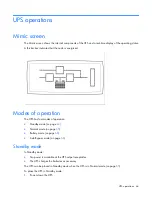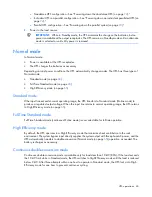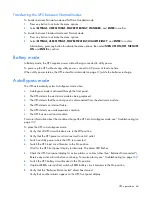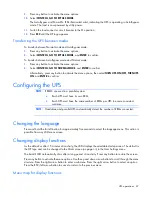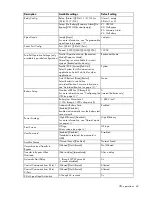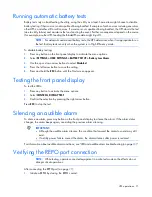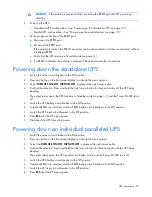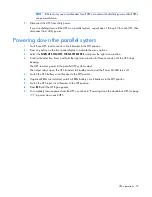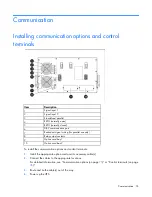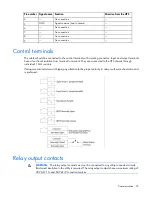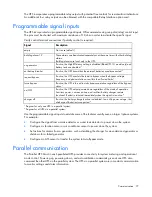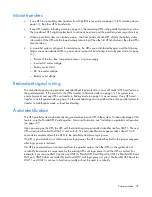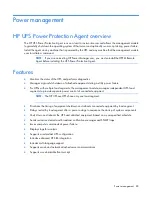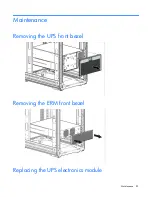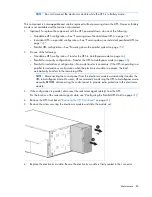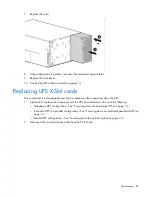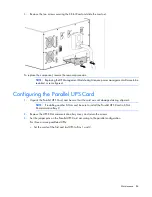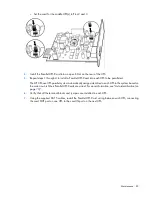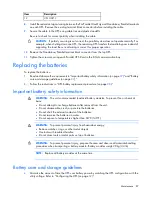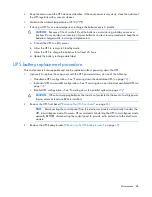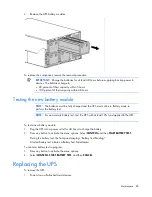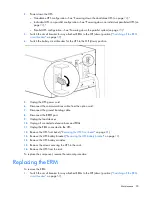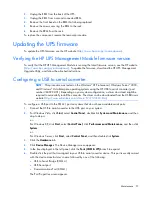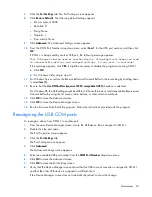
Communication 78
Mode transfers
•
If one UPS in a parallel system transfers from High Efficiency mode (on page
) to Normal mode (on
), the other UPSs transfer also.
•
If one UPS transfers to Battery mode (on page
), the remaining UPSs in the parallel system stay online.
The transferred UPS might transfer back to online at any time, and the parallel system resynchronizes.
•
When a parallel system is on battery power , the front panels of each UPS display the battery status
information of the UPS with the lowest runtime remaining. When the first UPS shuts down, the other UPSs
also shut down.
•
In a parallel system configured for redundancy, the UPSs use a distributed bypass, and the following
alarms cause an individual UPS to power down instead of transferring to Auto-Bypass mode (on page
o
Failure of the fan, fuse, temperature sensor, or power supply
o
Inverter AC under voltage
o
Battery current limit
o
DC line under voltage
o
Battery over voltage
Redundant signal wiring
The redundant signal wiring provides redundant backfeed protection in case of Parallel UPS Card failure in
the parallel system. If the card fails, the UPSs transfer to Normal mode (on page
). The system runs
unsynchronized, and any UPS can transfer to Battery mode (on page
) as necessary. If any UPS must
transfer to Auto-Bypass mode (on page
), the redundant signal wiring allows the entire parallel system to
transfer to Auto-Bypass mode, without backfeeding.
Auto-identification
The UPS parallel system automatically assigns identities to each UPS in the system. To take advantage of this
feature, wire the Parallel UPS Cards together. For more information, see "Installing in a parallel configuration
(on page
)."
Upon powering up the UPS, the UPS with the initializing jumper installed identifies itself as UNIT 1. The next
UPS wired identifies itself as UNIT 2, and so forth. The auto-identification sequence takes about 15-20
seconds to complete after all the UPSs in the parallel system have logic power.
If a UPS is powered down or otherwise loses logic power, the UPS re-identifies itself in the proper sequence
after logic power is restored.
If a UPS is powered down and removed from the parallel system, the other UPSs in the system do not
re-identify themselves to compensate for the missing UPS until logic power to all the UPSs is cycled. For
example, if you remove UNIT 2 and rewire UNIT 3's Parallel UPS Card IN port to UNIT 1's Parallel UPS Card
OUT port, UNIT 3 does not re-identify itself as UNIT 2 until logic power is cycled. The Parallel UPS Cards for
UNIT 1 and UNIT 3 continue to function normally without the need to re-identify.

